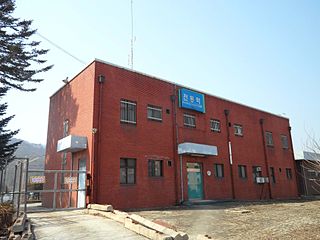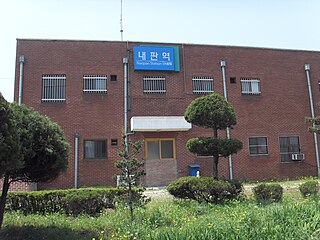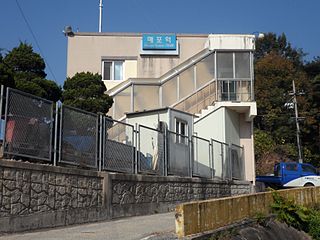This page is based on this
Wikipedia article Text is available under the
CC BY-SA 4.0 license; additional terms may apply.
Images, videos and audio are available under their respective licenses.

Boeun County (Boeun-gun) is a county in North Chungcheong Province, South Korea.

Goesan County (Goesan-gun) is a county in North Chungcheong Province, South Korea.

Jeungpyeong County (Jeungpyeong-gun) is a county in North Chungcheong Province, South Korea.

Icheon is a city in Gyeonggi Province, South Korea. It should not be confused with the much larger Incheon Metropolitan City. Neighboring districts include Yeoju City, Gwangju City, Yongin City, and Anseong City within Gyeonggi Province, as well as Eumseong County in North Chungcheong Province. Together with Yeoju, Icheon is known as a center of South Korean ceramic manufacturing and is a UNESCO City of Crafts and Folk Art. Other famous local products include peaches and rice. Local institutions of higher learning include Korea Tourism College and Chungkang College of Cultural Industries.

Geumsan County (Geumsan-gun) is a county in South Chungcheong Province, South Korea.

Sangju is a city in North Gyeongsang Province, South Korea. Although Sangju is rather rural, it is very old and was once a key city. Along with Gyeongju, it gives rise to half of the name of the Gyeongsang provinces. Sangju is nicknamed Sam Baek, or "Three Whites", referring to three prominent agricultural products rice, silkworm cocoons, and dried persimmons from the area.

Namhae County (Namhae-gun) is a county in South Gyeongsang Province, South Korea.
The sites of fossilized dinosaurs across the southern South Korean coast is a tentative UNESCO World Heritage site registered by the South Korean government since 2002. Although the evidence is rare, fossils reveal that there were dinosaurs in South Korea. The ancient remains of dinosaurs are located within a beautiful display of nature that includes petrified wood, the tracks of extinct dinosaurs and other animals, the exposure of geographic rock layers, and particular river drifts. This dinosaur park is well protected by the local governments and by the Marine National Park and is an invaluable resource for understanding the ecosystem and nesting behaviors of dinosaurs of the Mesozoic.

The Bukhan River is a tributary of the Han River that flows through both North and South Korea. It traverses Kangwon province in North Korea and Gangwon and Gyeonggi provinces in South Korea.

Jeonui Station is a railway station in Jeonui-myeon, Sejong City, South Korea.

Sojeong-ri Station is a railway station in Sojeong-myeon, Sejong City, South Korea.

Jeondong Station is a railway station in Jeondong-myeon, Sejong City, South Korea without passenger service.

Naepan Station is a signal box on the Gyeongbu Line in Yeondong-myeon, Sejong City, South Korea.

Bugang Station is a railway station on the Gyeongbu Line in Bugang-myeon, Sejong City, Republic of Korea.

Maepo Station is a railway station on the Gyeongbu Line in Bugang-myeon, Sejong City, South Korea.

Cheoin-gu is the largest gu in Yongin; it is located in the southeastern part of the city. It has 4 dong, 2 eup and 5 myeon.

Seobuk-gu is a non-autonomous district in the city of Cheonan in South Chungcheong Province, South Korea.

The Dongnam District is a non-autonomous district in the city of Cheonan in South Chungcheong Province, South Korea.
National Route 43 is a national highway in South Korea connecting Sejong City to Kosong County. It was established on 31 August 1971.
National Route 23 is a national highway in South Korea connects Gangjin County to Dongnam District, Cheonan. It established on 31 August 1971.




















